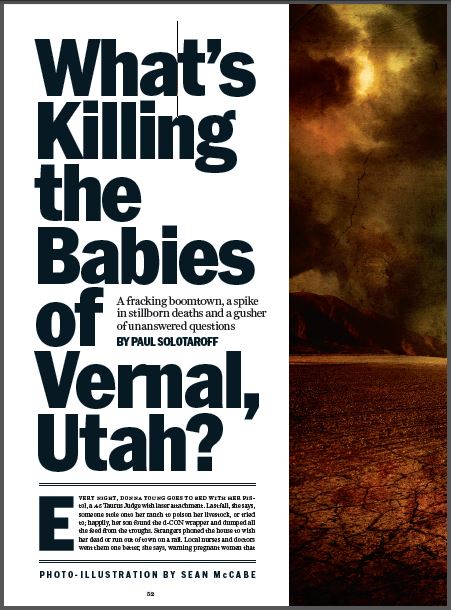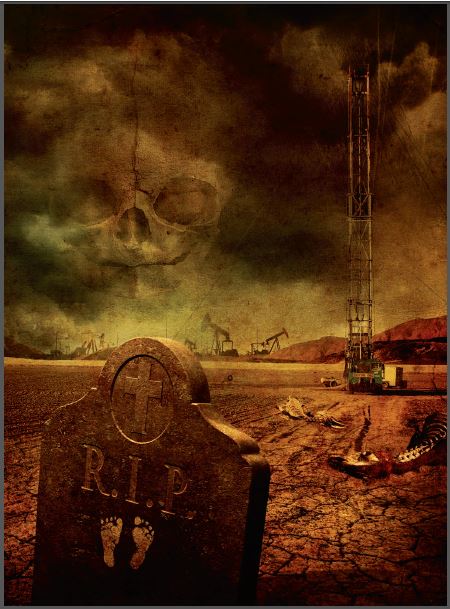Fracking kills newborn babies – polluted water likely cause by Oliver Tickell, 25th April 2017, The Ecologist
These results raise serious questions about potential health hazards of fracking, especially since the fetus and infant are most susceptible to environmental pollutants. This is a public health issue which should be investigated!
A new study of Pennsylvania counties published today in the Journal of Environmental Protection shows for the first time that contamination from fracking kills babies.
The Marcellus shale area of Pennsylvania was one of the first regions where novel gas drilling involving hydraulic fracturing of sub-surface rock, now termed ‘fracking’, was carried out.
The epidemiological study by Christopher Busby and Joseph Mangano examines early infant deaths 0-28 days before and after the drilling of fracking wells, using official data from the US Centre for Disease Control to compare the immediate post-fracking four year period 2007-2010 with the pre-fracking four-year period 2003-2006.
Results showed a statistically significant 29% excess risk of dying age 0-28 days in the ten heavily fracked counties of Pennsylvania during the four-year period following the development of fracking gas wells. Over the same period, the State rate declined by 2%.
They conclude:
“There were about 50 more babies died in these 10 counties than would have been predicted if the rate had been the same over the period as all of Pennsylvania, where the incidence rate fell over the same period.”
Radioactive water pollution to blame?
The Marcellus shale beneath Pennsylvania was one of the first areas where fracking began. Only 44 fracking wells were drilled before 2007, while 2,864 were drilled in 2007-2010.
The cause of the excess mortality is not proven in the study, however the authors point out that the fracking production process releases naturally occurring radioactive materials from shale strata which then contaminate groundwater.
These include radium, uranium, thorium and radon, an intensely radioactive gas which decays into radioactive ‘daughters’ with a half life of under four days. And as the authors write, fracking “involves the explosive destruction of large volumes of underground gas and oil retaining rocks and the pumping down of large amounts of what is termed ‘produced water’ which initially contains various chemical and sand additives.
“This produced water and backflow returns to the surface with a high load of dissolved and suspended solids including naturally occurring radioactive elements … The contaminated water has to be safely disposed of but this is often associated with violations of legal disposal constraints.”
Baby mortality related to exposure through water wells
In the five heavily-fracked counties in the northeast part of the state (Susquehanna, Bradford, Wyoming, Lycoming and Tioga), the number of deaths from 2003-2006 vs. 2007-2010 climbed from 36 to 60, a statistically significant rate increase of 66%.
The rate in the five counties in southwest Pennsylvania (Washington, Westmoreland, Greene, Butler and Fayette) rose 18%, from 157 to 178 deaths, though this increase was not statistically significant.
This divergence in relative risk between the heavily fracked NE and SW counties was initially perplexing, however the authors noticed the higher dependence on private water wells (potentially contaminated with frackiing fluids) for drinking water and other needs in the first region compared to the second.
In the NE group of counties , the number of water wells per birth ranged from 4.9 to 13.5, compared to 1.1 to 3 in the SW group of countries. Their chart of Relative Risk for early infant mortality after fracking (see image above right) plotted against ‘exposure’ defined as ‘water wells per birth’ on a county by county basis produced a straight-line graph – indicated a strong relation to increased mortality and exposure to groundwater.
|
County |
Water wells per birth |
Violations per birth |
RR |
|
North East Group |
|||
|
Susquehanna |
13.5 |
1.9 |
2.7 |
|
Bradford |
9.7 |
1.03 |
1.7 |
|
Wyoming |
9.45 |
0.44 |
1.5 |
|
Lycoming |
4.9 |
0.51 |
2.0 |
|
Tioga |
11.9 |
1.16 |
1.5 |
|
All North East |
8.4 |
0.22 |
1.67 |
|
South West Group |
|||
|
Washington |
2.5 |
0.08 |
1.27 |
|
Westmoreland |
2.1 |
0 |
1.1 |
|
Greene |
5.4 |
0.25 |
1.17 |
|
Butler |
5.7 |
0 |
0.9 |
|
Fayette |
1.13 |
0 |
1.3 |
|
All South West |
3.01 |
0.007 |
1.28 |
Table: Water wells per birth and violations per annual birth in highly fracked Pennsylvania Counties.
They conclude: “The results therefore seem to support the suggestion that the vector for the effect is exposure to drinking water from private wells. This is a mechanistically plausible explanation. However the findings do not prove such a suggestion. We may examine other possible explanations for possible health effects which have been advanced.”
While radioactive pollution is carefully examined, the authors acknowledge alternatives including “the existence of chemical contaminants in the produced water” which they consider a “possible but unknown factor.”
Serious questions raised over health hazards of fracking
“A major component of early infant mortality is congenital malformation, e.g., heart, neurological, and kidney defects. These are known to be caused by exposures to Radium and Uranium in drinking water”, said Christopher Busby.
“Infant death rates were significantly high in highly-fracked counties in northeast Pennsylvania, those with the greatest density of private water wells, suggesting it is drinking water contamination driving the effect.”
Joseph Mangano added: “These results raise serious questions about potential health hazards of fracking, especially since the fetus and infant are most susceptible to environmental pollutants. This is a public health issue which should be investigated wherever fracking is being carried out or proposed.”
The result is expected to have significant insurance, investment, economic and downstream political implications in the US and other countries. [Emphasis added]
The study: ‘There’s a world going on underground-infant mortality and fracking in Pennsylvania‘ is by Busby C C and Mangano J J and published in the Journal of Environmental Protection 8(4) 2017. doi: 10.4236/jep.2017.84028
Dr Busby is the Scientific Secretary of the European Committee on Radiation Risk www.ecrr.eu and is Scientific Director of Environmental Research SIA, based in the Latvian National Academy of Sciences, Riga, Latvia. Busby’s CV can be found here.
[Refer also to:
2016 06 16: The Most Horrific Frac Deregulation Yet? US EPA preparing for “widespread” radioactive frac waste contamination of drinking water or because it’s already happened? EPA’s proposed “protective regulation” to allow dramatically higher levels of radioactivity in drinking water THIS BEFORE TRUMP APPOINTED SCOTT PRUITT TO CASTRATE THE EPA.




2014 02 19: As Fracking Booms, Growing Concerns About Toxic, Radioactive Wastewater
2014 02 05: Hocus Pocus! Decades too late: Canadian regulator, the National Energy Board, asks for fracking fluid info, but not drilling additives which can be more toxic than frac chemicals DID THE NEB GET THE DETAILS THEY REQUESTED. PLEASE SOME ONE, FOIP FOR IT ]
2013 11 08: Elaine Hill: The Impact of Oil and Gas Extraction on Infant Health in Colorado
2013 10 11: Pennsylvania regulator allows radioactive, toxic drilling waste dumped as fill in city
2013 04 02: Radioactive Drilling Waste Shipped to Landfills Raises Concerns
2013 03 09: Radon gas leaks in coalbed methane fields in Australia spark call for probe
2012 11 29: Triangle Petroleum fracking radioactive waste water cleanup target missed in Nova Scotia
2012 10 19: Radioactive Frac Wastewater worries in Windsor
“You don’t put untreated fracking waste into sewage treatment plants,” the Minasville resident said. “Even if you don’t know to look at radioactivity, there’s huge questions about the chemicals.” … “For us, it’s even worse. We have these ponds sitting here, we still have most of the water in an unprotected location and nobody’s doing anything.”
2012 07 19: Link Between Low Birth Weight and Fracking, Says New Research
2006 10 02: New Brunswick Spill site is free of radioactive waste, says Corridor Resources
A resource company says it has cleaned up 3,000 litres of material containing a low-level radioactive substance it spilled while drilling for natural gas in the Sussex area in August.
The material that Corridor spilled is called frac sand and isused to fill rock fissures when drilling for natural gas. Frac sand contains some low-level radioactive isotopes.
The spill occurred Aug. 23 at a drill site on land belonging to a family in Penobsquis, said Corridor president Norm Miller.
“It was cleaned up immediately under strict supervision by the Environment Department and no risk of any significance to any personnel,” said Miller.
The company buried the material temporarily on another landowner’s property, he said.
According to federal regulations, the frac sand must be buried under at least 30 centimetres of soil to be neutralized.

A new study in Pennsylvania, USA shows that fracking is strongly related to increased mortality in young babies.
The effect is most pronounced in counties with many drinking water wells indicating that contamination by ‘produced water’ from fracking is a likely cause. Radioactive pollution with uranium, thorium and radium is a ‘plausible explanation’ for the excess deaths.